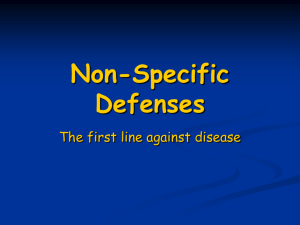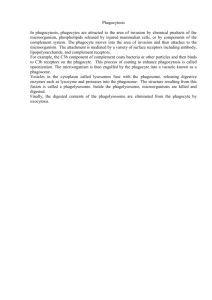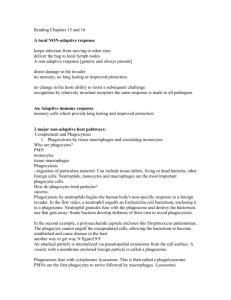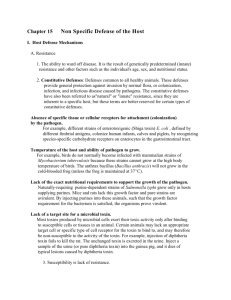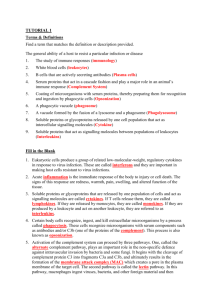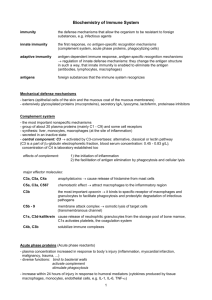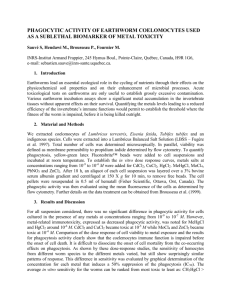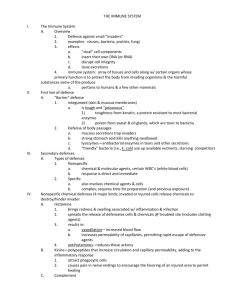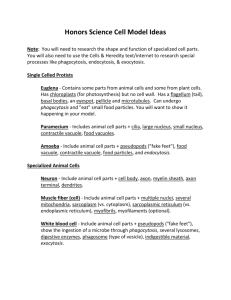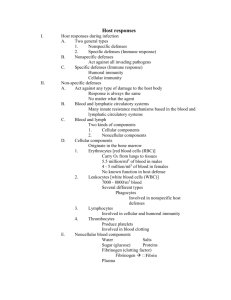Nonspecific Defenses of the Host
advertisement
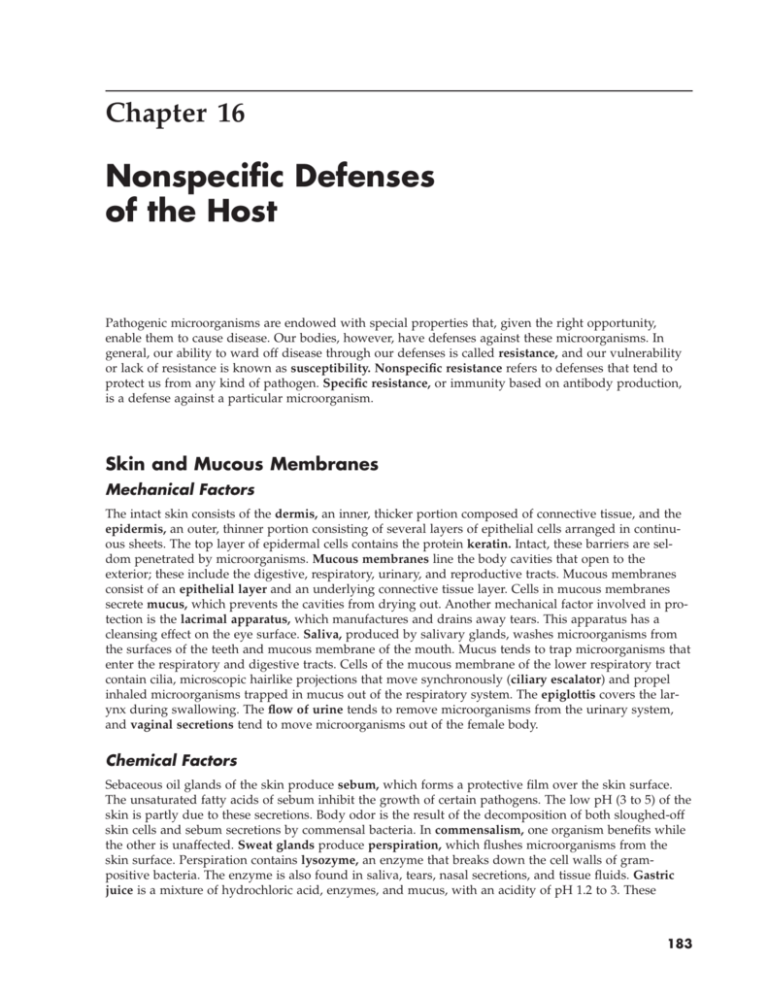
Chapter 16 Nonspecific Defenses of the Host Pathogenic microorganisms are endowed with special properties that, given the right opportunity, enable them to cause disease. Our bodies, however, have defenses against these microorganisms. In general, our ability to ward off disease through our defenses is called resistance, and our vulnerability or lack of resistance is known as susceptibility. Nonspecific resistance refers to defenses that tend to protect us from any kind of pathogen. Specific resistance, or immunity based on antibody production, is a defense against a particular microorganism. Skin and Mucous Membranes Mechanical Factors The intact skin consists of the dermis, an inner, thicker portion composed of connective tissue, and the epidermis, an outer, thinner portion consisting of several layers of epithelial cells arranged in continuous sheets. The top layer of epidermal cells contains the protein keratin. Intact, these barriers are seldom penetrated by microorganisms. Mucous membranes line the body cavities that open to the exterior; these include the digestive, respiratory, urinary, and reproductive tracts. Mucous membranes consist of an epithelial layer and an underlying connective tissue layer. Cells in mucous membranes secrete mucus, which prevents the cavities from drying out. Another mechanical factor involved in protection is the lacrimal apparatus, which manufactures and drains away tears. This apparatus has a cleansing effect on the eye surface. Saliva, produced by salivary glands, washes microorganisms from the surfaces of the teeth and mucous membrane of the mouth. Mucus tends to trap microorganisms that enter the respiratory and digestive tracts. Cells of the mucous membrane of the lower respiratory tract contain cilia, microscopic hairlike projections that move synchronously (ciliary escalator) and propel inhaled microorganisms trapped in mucus out of the respiratory system. The epiglottis covers the larynx during swallowing. The flow of urine tends to remove microorganisms from the urinary system, and vaginal secretions tend to move microorganisms out of the female body. Chemical Factors Sebaceous oil glands of the skin produce sebum, which forms a protective film over the skin surface. The unsaturated fatty acids of sebum inhibit the growth of certain pathogens. The low pH (3 to 5) of the skin is partly due to these secretions. Body odor is the result of the decomposition of both sloughed-off skin cells and sebum secretions by commensal bacteria. In commensalism, one organism benefits while the other is unaffected. Sweat glands produce perspiration, which flushes microorganisms from the skin surface. Perspiration contains lysozyme, an enzyme that breaks down the cell walls of grampositive bacteria. The enzyme is also found in saliva, tears, nasal secretions, and tissue fluids. Gastric juice is a mixture of hydrochloric acid, enzymes, and mucus, with an acidity of pH 1.2 to 3. These 183 184 Chapter 16 stomach secretions destroy many ingested microorganisms and toxins. Blood contains iron-binding proteins (transferrins) that inhibit bacterial growth by reducing available iron. Normal Microbiota and Nonspecific Resistance The normal microbiota, by competitive exclusion, can often prevent coloization by pathogens. Phagocytosis Operating within the body is the host’s second line of defense, of which phagocytosis is an important element. The word phagocytosis derives from the Greek words for “eat” and “cell” and refers to the ingestion of a microorganism or any particulate matter by a cell. Phagocytes are blood cells or derivatives of blood cells that perform this function (Figure 16.1). Formed Elements in Blood Blood fluid is called plasma, and cells and cell fragments of the blood are the formed elements. Most important for the present discussion are the leukocytes, or white blood cells. An increase in the number of white blood cells during infection is called leukocytosis. Decreased leukocyte counts are called leukopenia. A differential white blood cell count detects leukocyte number changes. Leukocytes are subdivided into the following three categories: 1. Granulocytes have granules in the cytoplasm and are differentiated into neutrophils, which stain pale lilac with a mixture of acidic and basic dyes; basophils, which stain blue-purple with basic methylene blue; and eosinophils, which stain red or orange with the acidic dye eosin. Neutrophils Microbe or other particle Plasma membrane 1 1 Chemotaxis and adherence of microbe to phagocyte. 2 Ingestion of microbe by phagocyte. 3 Formation of a phagosome. 4 Fusion of the phagosome with a lysosome to form a phagolysosome. 5 Digestion of ingested microbe by enzymes. 6 Formation of residual body containing indigestible material. 7 Discharge of waste materials. 2 3 Pseudopod Phagosome (phagocytic vesicle) Cytoplasm Lysosome 4 Phagolysosomes Digestive enzymes 5 Partially digested microbe Phagocyte ( ) Ph f h FIGURE 16.1 Residual body 6 Indigestible material 7 i The mechanism of phagocytosis in a phagocyte. Nonspecific Defenses of the Host 2. 3. 185 also are known as polymorphonuclear leukocytes (PMNs), or polymorphs. Agranulocytes have granules, which are not visible by light microscopy. Neutrophils (which account for 60% to 70% of leukocytes) are important in phagocytosis; basophils (0.5% to 1% of leukocytes) release histamine, a factor in inflammation and allergic responses; and eosinophils perform some phagocytosis but mainly attach to the outer surface of helminthic parasites and discharge lethal peroxide ions. Eosinophils increase in numbers during parasitic infections and allergic reactions. Lymphocytes (important to specific immunity) are not phagocytic. They occur in lymphoid tissue. Monocytes also lack granules and are phagocytic only after maturing into macrophages. Actions of Phagocytic Cells Granulocytes and monocytes migrate to sites of infection. Granulocytes are mostly neutrophils that wander in the blood and can pass through capillary walls to reach trauma sites. Macrophages are highly phagocytic cells called wandering macrophages because of their ability to migrate. Fixed macrophages (histiocytes) enter tissues and organs and remain there. Examples are Kupffer cells in the liver. The fixed macrophages are referred to as the mononuclear phagocytic (reticuloendothelial) system. Granulocytes predominate early in infections, as indicated by differential counts; as infections subside, monocytes predominate. Table 16.1 shows the classification of phagocytes. TABLE 16.1 Formed Elements in Blood Type of Cell Numbers per Micromliter (µl) or Cubic mm (mm3) Function Erythrocytes (red blood cells) 4.8–5.4 million Transport of O2 and CO2 Leukocytes (white blood cells) A. Granulocytes (stained) 1. Neutrophils (PMNs) (60–70% of leukocytes) 5000–10,000 Phagocytosis 2. Basophils (0.5–1%) Production of histamine 3. Eosinophils (2–4%) Production of toxic proteins against certain parasites; some phagocytosis B. Agranulocytes (stained) 1. Monocytes (3–8%) Phagocytosis (when they mature into macrophages) 2. Lymphocytes (20–25%) Platelets *Discussed in Chapter 17. Antibody production (descendants of B lymphocytes); cell-mediated immunity (T lymphocytes)* 150,000–400,000 Blood clotting 186 Chapter 16 Mechanism of Phagocytosis Chemotaxis and Adherence. Adherence, or attachment between the cell membrane of the phagocyte and the organism, is facilitated by chemotaxis, which is the attraction of microorganisms to chemicals. Opsonization—coating a microorganism with plasma proteins such as antibodies and complement— promotes phagocytosis. Ingestion and Digestion. Following adherence, projections of the cell membrane of the phagocyte (pseudopods) engulf the microorganism and then fold inward, forming a sac around it called a phagosome or phagocytic vesicle. This process is called ingestion. Within the cell, enzyme-containing phagosomes and lysosomes of the cell fuse to form a larger structure, the phagolysosome, within which the bacteria are usually quickly killed (Figure 16.1). Enzymes in lysosomes include lysozyme, various hydrolytic enzymes, and myeloperoxidases. Their action is a process called an oxidative burst. Indigestible material in the phagolysosome is called the residual body and moves to the cell boundary, where it is discharged. Microbial Evasion of Phagocytosis Some microbes evade adherence by phagocytes with structures such as M proteins or capsules. Others may be ingested but not killed. For example, they produce leukocidins and other complexes that kill the phagocyte. Still others can survive inside phagocytes and even multiply. Inflammation Inflammation is a host response to tissue damage, characterized by redness, pain, heat, swelling, and perhaps loss of function. It is generally beneficial, serving to destroy the injurious agent, to confine or wall it off, and to repair or replace damaged tissue. Vasodilation and Increased Permeability of Blood Vessels Vasodilation is the first stage of inflammation; it involves an increase in blood vessel diameters, and therefore more blood flow, in the injured area. Increased permeability allows defense substances in the blood to pass through the walls of the blood vessels. Vasodilation is also responsible for the redness, heat, edema (swelling), and pain of inflammation. Histamine is released by injury and increases permeability as well. Kinins cause vasodilation and also increase permeability and attract phagocytes. Prostaglandins (substances released by damaged cells) and leukotrienes (substances produced by most cells and related to prostaglandins) cause increased permeability of blood vessels and help attach pathogens to phagocytes. Clotting elements in the blood help prevent the spread of the infection. A localized collection of pus (dead phagocytic cells and body fluids) in a cavity is called an abscess. Phagocyte Migration and Phagocytosis Within an hour of the beginning of inflammation, phagocytes appear at the site. Blood flow decreases as the phagocytes stick to the inner lining of blood vessels (margination) and then pass through the vessel wall to the damaged area. This emigration is called diapedesis. Monocytes appear later in the inflammatory response and mature into macrophages. Macrophages ingest dead tissue and invading microorganisms. Tissue Repair The final stage of inflammation is tissue repair, which involves production of new cells by the stroma (supporting connective tissue) and the parenchyma (functioning part of tissue). Scar tissue results from stroma-type repair. Nonspecific Defenses of the Host 187 Fever The hypothalamus controls body temperature (normally 37°C or 98.6°F). The setting can be altered by ingestion of gram-negative bacteria by phagocytes. The resulting release of endotoxins causes release of a cytokine called interleukin-1 (endogenous pyrogen). Another fever-inducing cytokine called alpha tumor necrosis factor is produced by macrophages and mast cells. (Cytokines are immune system chemical messengers and are discussed in Chapter 17). A chill (cold skin and shivering) is a sign of fever (rising temperature). Crisis refers to a very rapid fall in temperature. Fevers are often beneficial as aids to body tissue repair and inhibitors of microbial growth. Antimicrobial Substances The Complement System Complement consists of a group of over 30 different proteins found in blood serum. Blood serum is the liquid portion of blood that remains after it is drawn and clotting proteins form a clot with the formed elements. Complement participates in lysis of foreign cells, inflammation, and phagocytosis. The system can be activated by an immune reaction in the classical pathway, the alternative pathway, or the newly discovered lectin pathway. The complement proteins act in an ordered sequence, or cascade; one protein activates another. Protein C3, as shown in Figure 16.2, plays a central role in both the classical and the alternative pathways. In the classical pathway, activity is initiated when antibody molecules bind to the antigen—a bacterial cell, for example. In the alternative pathway, which does not involve antibodies, complement proteins, and proteins called factors B, D, and P (properdin), combine with certain microbial polysaccharides. Especially affected are the lipopolysaccharide cell wall portions (endotoxins) of gram-negative enteric bacteria. In the lectin pathway macrophages stimulate the liver to release lectins. These enhance opsonization by binding to cell carbohydrates. The Result of Complement Activation. Cytolysis: Complement protein then binds to two adjacent antibodies and initiates a sequence known as the membrane attack complex. Circular lesions called transmembrane channels (membrane pores) are formed and cause the eventual lysis of the cell, to which the antibodies are attached. Inflammation also can develop from complement. Other complement proteins combine with mast cells and trigger the release of histamine, which increases blood vessel permeability. One protein chemotactically attracts phagocytes to the site. Opsonization, or immune adherence, promotes attachment of a phagocyte to the microbe. Complement involvement results from interaction with special receptors on the phagocytes. Interferons (IFNs) Interferons of three types (alpha and beta, which are produced by virus-infected host cells; and gamma, which is produced by lymphocytes and kills bacteria) are proteins. They tend to interfere with viral multiplication by inducing the uninfected cell to manufacture mRNA for synthesis of antiviral proteins. One example is synthetase oligoadenylate synthetase, which degrades viral mRNA; another is protein kinase, which inhibits protein synthesis. Interferons are most important in protection against acute virus-caused infections, such as influenza. Interferons can be produced by biotechnological methods and have been tested to determine their antiviral and anticancer effects. The three types have different effects. 188 Chapter 16 C3 1 2 C3b C3a C5 Histamine 3 Opsonization: Enhancement of phagocytosis by coating with C3b 5 C5b 4 C5a C6 Mast cell C7 C8 Inflammation: Increase of blood vessel permeability and chemotactic attraction of phagocytes C9 Microbial plasma membrane C5b C6 C7 C8 C9 Cytolysis: Loss of cellular contents through transmembrane channel formed by membrane attack complex C5–C9 FIGURE 16.2 Outcomes of complement activation. Note the cleavage of C3 into C3a and C3b. These fragments induce three kinds of consequences destructive to microorganisms: cytolysis, inflammation, and opsonization. Nonspecific Defenses of the Host 189 Self-Tests In the matching section, there is only one answer to each question; however, the lettered options (a, b, c, etc.) may be used more than once or not at all. I. Matching 1. Produces tears. a. Dermis 2. The outer layer of the skin. b. Epidermis 3. An oily substance forming a protective film over the skin surface. c. Mucus 4. Secreted by cells in mucous membrane; prevents the cavities from drying. 5. Covers larynx during swallowing. 6. The inner portion of the skin, composed of connective tissue. d. Mucous membrane e. Lacrimal apparatus f. Sebum g. Epiglottis II. Matching 1. The blood fluid. a. Serum 2. Cells and cell fragments of the blood. b. Plasma 3. Immunity based on antibodies. c. Formed elements 4. Movement by a microorganism toward an attractant chemical. d. Susceptibility 5. An increase in the diameter of blood vessels. 6. A collection of dead phagocytic cells and fluids. 7. Vulnerability to a pathogen. e. Specific resistance f. Chemotaxis g. Vasodilation h. Pus i. Opsonization III. Matching 1. Neutrophils. 2. Monocytes. a. No granules in cellular cytoplasm; important to specific immunity 3. Lymphocytes. b. Granulocytes c. Mature into macrophages 190 Chapter 16 IV. Matching 1. An increase in the number of white blood cells. a. Pseudopods 2. Projections of the cell membrane of a phagocyte. b. Phagolysosome 3. A larger structure formed when lysosome and phagosome fuse. c. Phagosome 4. A decrease in the number of white blood cells. d. Lysozyme e. Lysosome f. Leukocytosis g. Leukopenia V. Matching 1. Blood flow decreases as phagocytes stick to the inner lining of blood vessels. 2. Complement reacts with mast cells and attached antibodies to release this compound. 3. A protein in blood that inhibits microbial growth by reducing the amount of available iron. a. Diapedesis b. Hypothalamus c. Margination d. Transferrin e. Histamine 4. Controls body temperature. 5. Emigration of phagocytes through the vessel wall to damaged tissue. VI. Matching 1. Polymorphonuclear leukocytes. a. Neutrophils 2. Most numerous granulocytes in blood. b. Basophils 3. Stain red or orange with the acidic dye eosin. c. Eosinophils 4. Attach externally to large parasites such as worms and lyse them by discharge of peroxides. d. Monocytes 5. Granulocytes that stain with basic methylene blue dyes. 6. Become macrophages. 7. Kupffer cells in the liver, for example. e. Macrophages Nonspecific Defenses of the Host 191 Fill in the Blanks 1. Some cells of the mucous membrane of the lower respiratory tract contain , which are microscopic, hairlike projections. 2. The glands produce perspiration. 3. Complement acts in a sequence called a . 4. In the membrane attack complex associated with the action of complement, circular lesions called channels are formed. 5. is a group of more than 30 proteins found in blood serum. 6. Lymphocytes and monocytes do not have in their cytoplasm. 7. The coating of a microorganism with plasma proteins such as antibodies and complement is called and promotes phagocytosis. 8. Scar tissue results from -type repair. 9. The complement pathway that does not involve antibodies is called the pathway. 192 Chapter 16 Label the Art a. b. h. c. d. i. e. j. k. l. m. f. g. Critical Thinking 1. List and briefly discuss the nonspecific defense mechanisms that help prevent infection of the respiratory tract. 2. How do some bacteria overcome the strongly acidic environment of the stomach to cause disease? Nonspecific Defenses of the Host 193 3. Define phagocytosis. How do some bacteria avoid or survive the action of phagocytes? 4. Compare and contrast the roles of wandering macrophages and fixed macrophages. 5. Define opsonization. How does opsonization help enhance phagocytosis? Answers Matching I. II. III. IV. V. VI. 1. e 1. b 1. b 1. f 1. c 1. a 2. b 2. c 2. c 2. a 2. e 2. a 3. f 3. e 3. a 3. b 3. d 3. c 4. c 5. g 6. a 4. f 5. g 6. h 7. d 4. g 4. b 5. a 4. c 5. b 6. d 7. e Fill in the Blanks 1. cilia 2. sweat 3. cascade 8. stroma 9. alternative 4. transmembrane 5. complement 6. granules 7. opsonization Label the Art a. Tonsil b. Right lymphatic duct c. Right subclavian vein d. Thymus gland e. Lymphatic vessel f. Bone marrow g. Lymphatic vessel h. Left subclavian vein i. Thoracic duct j. Spleen k. Small intestine l. Peyer’s patch m. Lymph node Critical Thinking 1. • • • • Mucous membranes lining the respiratory tract help prevent the penetration of pathogens. Mucus-coated hairs of the nose trap microbes, dust, and so on. The ciliary escalator helps remove microbes from the lower respiratory tract. The epiglottis covers the larynx during swallowing, preventing microbes from entering the lower respiratory tract. 2. Bacteria such as Clostridium botulinum and Staphylococcus aureus don’t actually survive stomach acids. Instead, they produce acid-resistant toxins that produce the symptoms of the diseases that they cause. Other microorganisms are protected from the effects of acid by food particles. Finally, the bacterium Helicobacter pylori is able to neutralize the acid and grow in the stomach lining. 3. Phagocytosis refers to the ingestion of microorganisms or particulate matter by a cell. Phagocytosis is a means by which the body counters infection. • Lipids in the cell wall of Mycobacterium help it to avoid phagocytosis. • Capsules help bacterial cells avoid phagocytosis. • Toxins produced by staphylococci and Actinobacillus kill phagocytes. • Some cells evade the immune system by entering and reproducing inside phagocytes. • Some microorganisms prevent fusion of the phagosome with a lysosome, preventing digestion. • M proteins of streptococci inhibit attachment of phagocytes. 4. Wandering macrophages and fixed macrophages make up the mononuclear phagocytic system. Wandering macrophages develop from monocytes that migrate to the infected area. They leave the blood and migrate to the infected area, where they scavenge and phagocytize bacteria and debris. Fixed macrophages are located in certain tissues such as the liver, lungs, and nervous system. Fixed macrophages remove microorganisms from blood or lymph as these substances pass through the organs. 5. Opsonization refers to the coating of microorganisms with certain plasma proteins to promote attachment and phagocytosis.
